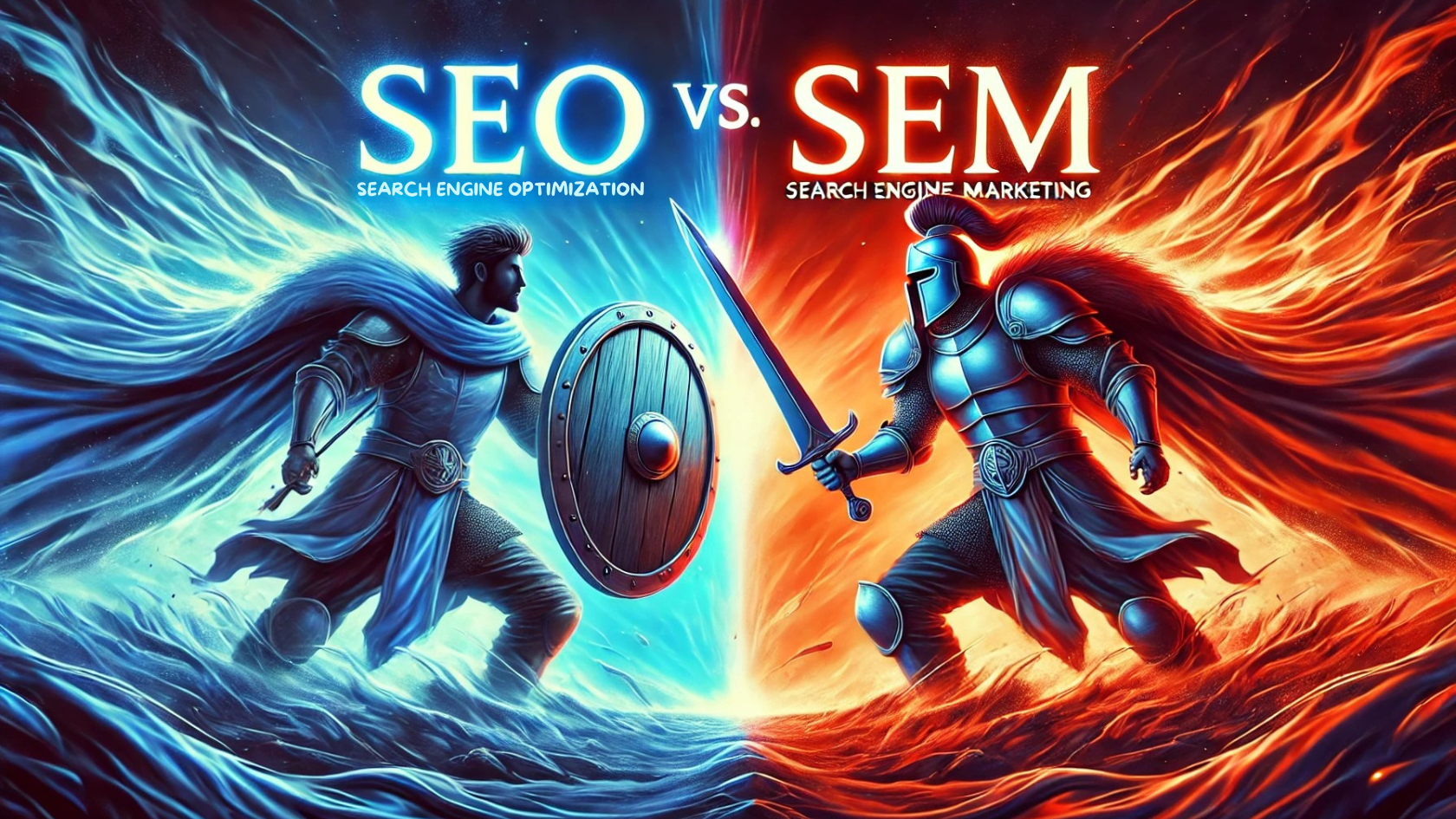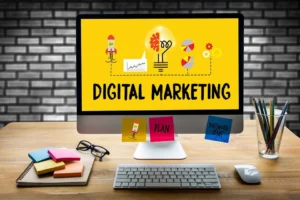Quick Summary
- Know the basics about SEO (Search Engine Optimization) focusing on organic search rankings and SEM (Search Engine Marketing) considered broadly as paid ads, but include organic and paid marketing both.
- Learn the difference between SEO and SEM
- Know when is a good time to use which strategy and channel!
Table of Contents
- What is SEO?
- No longer Search Engine, but Search Everywhere Optimization!
- Keyword Research
- On-Page SEO
- Off-Page SEO
- Technical SEO
- What is SEM?
- Keywords for Ads
- Bid Setting
- Ad Creation
- Audience Targeting
- SEO vs. SEM: A Side-by-Side Comparison
- How Long Does SEM Take?
- How Much Does SEO and SEM cost?
- SEO or PPC: Which is the Best?
- FAQs
“…….. but I am not sure which one will be better. I’ve heard SEO can help with traffic, not leads. I’ll go with Paid Ads. But that shoes website got good results with SEO. Oh, I am so confused. SEO or SEM? Which one? I think I will……” And the time passes. The fact is, that business which chose SEM over SEO (or vice versa) did their own research.
Maybe they failed in the first and got success in another. Maybe they started with both and then continued with one which gave better results. There are many possibilities. Which one to choose?
Rather than relying on instincts and deciding, let’s know the basics and the possibilities of both. I’ve tried my best to outline the 101s and the expectations to set with both the types of digital marketing. Now, all you’ve to imagine is, which one will be more feasible for you!
Let’s get started
What is SEO?
Search Engine Optimization (SEO) is all about getting relevant traffic to your website and meeting the goals. Many can have a perspective which says “It is ranking your website pages on the first page of SERPs. Rather, first position when someone searches for a query related to your business!”. That’s true, but not the only way to approach SEO.
No longer Search Engine, but “Search Everywhere Optimization”!
In today’s ecosystem where algorithms and users both are smart enough to understand the authority before buying from a business, you need to do more. SEO today is not just Search Engine Optimization but “Search Everywhere Optimization”. Now before you go into the mode, “Oh come on, What is this now?” Please hear me out.
With AI and other preferred platforms like YouTube, Quora and Reddit gaining more and more popularity, people reach here to answer questions on their mind. So there is a huge scope to get traffic from here.
You need to know the fact that pulling traffic and conversions is your goal. Ranking on search engine results page (SERP) is only a great way to do so. But SEO experts know the way to do it.
SEO today involves getting authority from relevant platforms, basically creating a “BRAND PRESENCE” throughout the internet. Then driving this traffic to your website where outstanding content is awaiting them. Gaining trust of those users, and in turn getting traffic and conversions keep a long term impact. But all this should be genuine!
With this, it is also having a crawler or algorithm friendly website making sure they can read and understand every element on your web pages without confusing them.
Let’s see how it is done.
1. Keyword Research
Keyword research is the heart of SEO. It is “simple, but not simple”. Sounds confusing right? Let me explain, I said “it is simple” because it simply means before creating content, you need to understand what people are searching for. Simple? Now here comes the interesting “nightmare”.
Keyword research is often considered as “…… it’s only about finding keywords that are relevant to my page or blog. I will get a tool and insert my focus keyword. It’ll give me related keywords. I will use these keywords in my content as much as I can. BOOM! I am an SEO expert!” And here our SEO expert made a waste of their efforts, time and resources.
Keyword research is more than this, keyword difficulty, competitor analysis, user intent and many more things are to be considered or else, “……. we got nothing from SEO, entire digital marketing doesn’t deliver any results” these things are said.
This process, known as keyword research, helps you identify relevant phrases. For example, if you own a travel blog, targeting “budget travel tips” instead of “best travel hacks” might bring in more engaged visitors. You have to know what your users are expecting when they will be searching for the keywords you use.
2. On-Page SEO:
This includes optimizing various elements of your web pages:
- Title tags & meta descriptions – These are the first things people see in search results. A compelling title like “10 Easy Ways to Save Money on Travel” can improve your click-through rate.
- Content optimization – Google asks for well-structured, valuable content. Now here, Google is trying to deliver the quality for which it is trusted. So if your content is providing quality, search engines will help you get traffic. Instead of stuffing keywords, write naturally and answer your audience’s questions.
- Internal linking – Linking to other relevant pages on your site helps both users and search engines navigate better. Simply put, here you point to all the relevant and focus pages which can provide value to the visitors.
- User experience – If your site loads slowly or isn’t mobile-friendly, visitors might leave before reading your content. This comes mainly under technical SEO, but yes, having a good dependency on the content, loading speed should always be in check.
3. Off-Page SEO
While on-page SEO happens within your site, off-page SEO is about gaining credibility from external sources.
- Backlinks – This is what I meant earlier when I wrote about creating “BRAND PRESENCE”. If a high-authority site like Forbes links to your blog, search engines see your site as trustworthy. What will happen if more such websites are referring you for your niche?
Take this example, you reach your family doctor who has been treating your family for decades. Now, you ask him about a skin infection you have developed recently. He suggests showing yourself to a skin specialist with their name, address and phone number. What is the possibility of you going to some other skin specialist now?
Backlinks work the exact same way. When done well and consistently, they establish you as a “Brand” in the views of Search Engines.
- Social signals – Although not a direct ranking factor, engagement on social media can drive traffic and boost visibility. Social Media platforms are a part of push media. They show you the brand posts even when you didn’t ask for them, unlike search engines.
However, you find the content related to your interest. So the catch here is, social media helps people find your brand. And yet again, think what will happen if you are found on both, search engines and social media? You got it!
- Brand mentions – Even if other websites don’t link to you, just mentioning your brand can strengthen your online presence (but slowly). It is more or less like branding. But it won’t help you as much as linked mentions.
4. Technical SEO
Technical SEO ensures that search engines can easily crawl and index your website.
- Robots.txt and Sitemap – The first place where crawler visits on your website is robots.txt. Here it finds the open and closed doors for itself in your website. In robots.txt file, it finds the sitemap of your website! Now sitemap, simply put, is a blueprint map of your website where you mention the pages you want the crawler to visit and read.
Here, you are basically showing the pages you want to index on search engines. - Mobile-friendliness – Over half of web traffic comes from mobile users, so a responsive site is a must. This is not something unknown in today’s world, is it? Mobiles are the present and most probably the future of carrying technology with you (hopefully unless a technology beyond mobile phones isn’t invented and made affordable).
At a general level, there is hardly anything today for which we need only big screens. Browsing has become more common on mobiles. Infact, a few leading websites and platforms like Instagram are more mobile-friendly than desktops.
- Website speed – For a few people, technical SEO is equal to website speed. No it is not! No doubt, website speed is an important part of Technical SEO, I agree. But it is not the only thing included.
So, Technical SEO is about how well are crawlers finding your pages to be. Are they fit from all the angles to be shown on the first page of search engine results? Or they are missing a few factors which can hamper the user experience.
There is a popular saying for website speed – “Pages should load in under three seconds.” Which is somehow correct to provide your users a good experience as per the belief.
- Core Web Vitals – These are a few metrics considered to calculate the speed of your website. A few things that matter to the search engines. Having good core web vitals like LCP (<2.5s), INP (200 ms) and CLS (<0.1) shows that your website is meeting the basic needs required.
You can visit PageSpeed insights, enter your web page URL and hit “Analyze” to know if your webpages meet the requirements.
- Secure connections (HTTPS) – Google prioritizes secure websites and it is self-explanatory. Having an SSL (Secure Sockets Layer), a security protocol helps protect sensitive information (like passwords, credit card details, and personal data) from hackers. It encrypts data transmitted between a user’s browser and a website’s server.
This might’ve been an eye-opener to understand the basics of how SEO works and why it is so complicated. Many factors are involved in this channel of digital marketing but understanding the logic behind every guideline and algorithm update has only helped the businesses.
Now let’s understand the other end!
What is SEM?
SEM (Search Engine Marketing) is a way to get instant traffic by paying for ad placements on search engines. It is popularly known as PPC (Pay Per Click). You’ve probably seen Google Ads appear at the top of search results that contain a tag “sponsored” or “ad”—those are PPC ads.
Businesses bid on keywords, and every time someone clicks their ad, they pay a fee.
1. Keywords for Ads
Just like SEO, PPC requires keyword research. The goal here is to find search terms that potential customers use, but with a focus on those that are most likely to lead to conversions. Unlike SEO, you need to be more careful for keywords which are not meant for buying intent otherwise you lose money directly.
For example, a furniture company might target “buy wooden dining table” rather than just “dining table.” Why? Because people searching with “buy” are likely ready to make a purchase.
2. Bid Setting
Ever wondered how PPC ads get their ranking? It’s not just about throwing money at Google! While bidding on keywords plays a role, the highest bidder doesn’t always win. Google also looks at your ad’s relevance and quality before deciding where it ranks.
So, what matters more—budget or quality?
Let’s say two companies bid on the same keyword:
Company A has a huge budget but a poorly optimized landing page and a generic ad.
Company B has a smaller budget but a highly relevant ad, a fast-loading page, and great user experience.
Guess what? Company B can outrank Company A because Google rewards Quality Score—a mix of ad relevance, expected CTR, and landing page experience.
How Can You Improve Your Ad Rank Without Overspending?
- Write compelling ad copy that matches search intent.
- Optimize your landing page for speed and relevance.
- Improve your Quality Score by maintaining a high click-through rate (CTR).
So, before you increase your bid, ask yourself: Is my ad as relevant and engaging as possible? Sometimes, the smartest bid isn’t the highest—it’s the one that delivers the best experience!
3. Ad Creation
Simply put, keep your copy short, persuasive, and action-driven. A strong Call to Action (CTA) can make all the difference.
What makes a great ad?
A good ad isn’t just about describing your product—it should highlight a benefit and create urgency.
For example: Weak Ad: “Best Running Shoes Online” (Too generic, no clear reason to click.)
Stronger Ad: “Run Faster & Stay Comfortable – 20% Off Today!” (Benefit + Urgency = More Clicks)
So, How to Make Your Ad Stand Out? Focus on the user’s problem and solution (“Struggling with foot pain? Try our ultra-cushioned shoes.”).
Use numbers & discounts (“Save 30% on all fitness gear – Limited Time.”).
Create urgency (“Offer Ends Soon – Shop Now.”).
Before publishing, ask yourself: Would I click on this ad? If not, tweak it until it grabs attention and drives action.
4. Audience Targeting
With PPC, you can choose who sees your ads based on demographics, location, interests, and even past behavior. Ever browsed for a product and then seen ads for it everywhere? That’s retargeting, a powerful PPC strategy.
Many people have an opinion that SEM is an umbrella term that includes both SEO and PPC. It’s about increasing your visibility on search engines, whether through organic rankings or paid ads or a combination of both.
If SEO is like planting a tree that grows over time, SEM is like renting a billboard—instant exposure but at a cost. Most businesses use a mix of both to get the best results.
SEO vs. SEM: A Side-by-Side Comparison
Feature | SEO (Search Engine Optimization) | SEM (Search Engine Marketing) |
Traffic Source | Organic (unpaid) | Paid (PPC) + Organic |
Cost | No direct cost but requires time & effort | Paid (cost per click) |
Speed of Results | Takes months to see results | Instant visibility |
Sustainability | Long-term, sustainable | Short-term, requires ongoing spending |
Click-Through Rate (CTR) | Higher for top-ranked organic results | Can be lower than organic but appears above search results |
How Long Does SEM Take?
PPC campaigns can start driving traffic the same day they’re launched. However, optimizing them for the best return on investment (ROI) takes time—usually a few weeks to months.
SEO, on the other hand, is a long game. Depending on competition and strategy, it can take 3 to 6 months to see noticeable improvements, and up to a year to rank for highly competitive keywords.
How Much Does SEO and SEM cost?
- SEO is technically free but requires time and effort. Many businesses hire agencies or specialists, which can range from $500 to $5000 per month. Businesses need to know about paid backlink strategies, they can demand for investments but give you long term, sustainable results.
- PPC costs depend on industry and keyword competition. Some industries, like legal services, have CPCs as high as $50 per click, while others like retail may pay just $1 per click.
SEO or PPC: Which is the Best?
The answer depends on your business goals:
- Need instant traffic? Go with PPC. It will act as per your budget and ad setup expertise but will provide you instant results while using your money.
- Want sustainable growth? Invest in SEO. It will create a good online presence and will give you long term results targeting multiple goals you might have like awareness (through blogs), leads through CRO or simply traffic.
- Want the best of both worlds? Use both together. This can be a great option as SEO takes care of the sustainability and long term goals and PPC or Search Ads take care of instant results appearing on the top of Search Engine Results Page.
FAQs
SEO focuses on organic search traffic, while SEM is an umbrella term including both SEO and paid search ads (PPC). However, SEM is generally referred to as paid ads.
Neither is inherently better; SEO is long-term and cost-effective, while SEM provides immediate results.
It depends on your industry, competition, and goals. Some businesses spend a few hundred dollars, while others invest thousands per month.
SEO typically takes 3-6 months to show significant results, depending on keyword competition and strategy.
Yes, a combined strategy often works best to maximize visibility and conversions.


